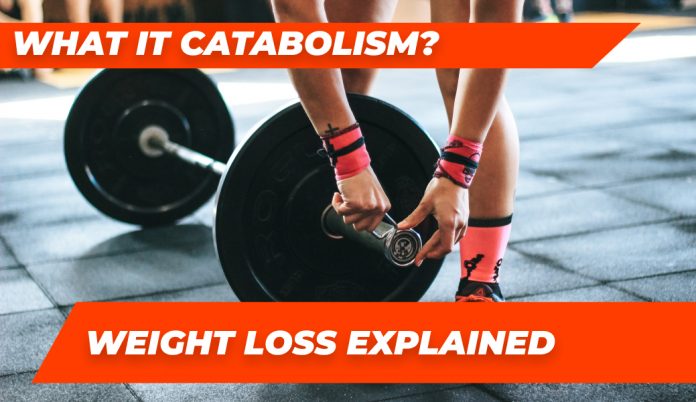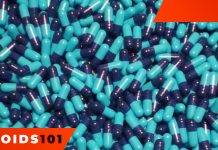Catabolism is essential when building your perfect body. Nevertheless, almost every athlete knows that it is impossible to grow in a perfect progression. Everyone struggles with this issue in their own way. Hardgainers appeared precisely because of the impossibility to grow continuously. Have you seen bodybuilders who eat on a schedule and constantly stuff themselves with anabolic steroids? Why is all this necessary? The answer is one word – catabolism.
What is Catabolism?
Catabolism is an integral part of metabolic processes in the body. What is it? Two words – resource optimization. Our body works like a pendulum, continually creating new cells, and destroying old ones. In fact, over five years, you are a completely different person (physically, at least). But that is not all.
In the biochemical sense, catabolism is the decomposition of complex substances into simpler ones or the oxidation of various molecules. The process proceeds with the release of energy in forms of:
- heat;
- ATP molecules – the primary source of energy for any biochemical reaction.
Catabolism and anabolism are in constant balance and directly depend on the following factors:
- hormones, since these substances are the central regulators of catabolism and anabolism;
- the necessity to shift the balance;
- nutrition;
- metabolic rate;
- the amount of sleep;
- other factors.
Let us consider a simple example of the processes of optimizing the body’s resources. Initially, during the day, the body strives for the breakdown of energy and the synthesis of new cells.
At night, a reboot occurs, and he begins to terminate unnecessary cells, breaking them down and preparing for renewal.
Under stress, catabolic processes are significantly accelerated. However, in this case, the acceleration of catabolism occurs in preparation for a potent anabolic spike. All cells that are unable to withstand new levels of stress are destroyed, being replaced by more resilient ones.
The level of physical strain is precisely the factor that affects the shift in the balance between anabolic and catabolic processes.
When the stresses in the body pass (for example, a person stops to train regularly), the body optimizes resources to survive in the event of hunger or other stressful circumstances. Muscle breakdown can be observed. It is especially noticeable in athletes after the end of their careers. Usually, they lose up to 40% of the accumulated muscle mass.
Physical activity is not the only factor that shifts the balance between catabolism and anabolism. Any change in day mode or nutrition can move tip the scales in one direction or another.
Physiology of Catabolism
The physiology of catabolism is the breakdown of substances with their subsequent oxidation. In the process of metabolism, any activity provokes the beginning of the general routine of catabolism. During a stressful situation (physical or mental stress), the body begins to consume a large amount of glycogen. Subsequently, if the oxygen in the blood is sufficient, muscle ATP breakdown begins, which provokes the destruction and microtrauma of muscle tissue.
Catabolism is not a bad thing per se. After all, the process concerns not only muscle but also adipose tissue. In particular, many diets and training complexes for ripping involve activation of catabolic processes to remove lipids from cells opened by insulin, followed by their oxidation and transformation into energy.
Stages of Catabolism
Since catabolism is a cyclic process, it has active and passive phases combined with anabolism. Let us consider the stages of catabolism in more detail:
- Stress;
- Destruction;
- Supercompensation OR Optimization;
- Balance.
From the first stage, the body begins to consume reserved resources actively. Stress is considered to be practically all human activities that go beyond the usual daily routine. So, muscle catabolism can be provoked by:
- changing the daily routine, sleep time reduction;
- abnormal muscle strain;
- changing the nutrition plan;
- increased intake of adrenaline stimulants.
In the process of suffering stress, the body begins to destroy reserved resources (starting with glycogen, which is predominantly stored in muscle tissue, and ending with the muscles themselves). If the body manages to keep some reserved energy sources or timely replenishment is made, then the process of supercompensation begins.
An interesting fact: have you noticed that with mental stress, the body actively requires sweets or the fact that some find refuge from all their problems and sorrows in cakes and ice cream. The reasons for that are not only the presence of stimulators of the «hormone of joy,» but also the natural need of the body to restore strength and prepare the body for possible stresses.
If the body does not have backup sources for recovery, then the optimization stage begins. At this point, the synthesis of ATP and glycogen stops, and the body itself reduces energy consumption, due to the gradual destruction of energy-consuming parts.
The most energy-hungry parts of our bodies are muscles and the brain.
Starvation provokes not only the reduction of muscle mass but also brain destruction. Therefore, people who are constantly deficient in calories become actually more feeble-minded compared to their well-fed counterparts.
After the end of optimization (or supercompensation), the body balances the anabolic and catabolic processes. Usually, this step takes up to 48 hours until the body is stabilized.
For the same reason, people not taking anabolic steroids should take a 48-hour minimum break between workouts.
The processes of catabolism include:
- tissue oxidation;
- a shift in ATP balance;
- cessation of ATP synthesis;
- breakdown of amino acids into energy.
- lipid balance shift;
- change in the size of the glycogen storage.
All this is surely not everything that may be happening during catabolism.
In general, biochemistry-wise, the stages of the pathway of catabolism are as follows:
- Digestion in the gastrointestinal tract is a chain of reactions, as a result of which complex molecules turn into simpler metabolites. Glucose, fatty acids, amino acids appear in the body that way;
- the breakdown of simple metabolites to pyruvic acid or acetyl-CoA.
- Oxidative decarboxylation of pyruvate, citrate cycle, and respiratory chain – the final stage of catabolism, results in the final products forming from food components.
Biochemical processes are quite complex, and in each case, catabolism takes place individually.
Slowing It Down
Upon consideration of the specific and general ways of catabolism, the impossibility of stopping catabolism becomes evident. At the same time, one can look for ways to slow it down.
The rate of catabolism is directly related to the rate of metabolism. Even though people think that slow metabolism leads to weight gain and catabolism – this is not entirely true. Therefore, if your goal is to slow down catabolism, there are three main ways:
- increase the duration of anabolic processes;
- reduce the level of stress for the body;
- slow down the metabolism.
To increase anabolic processes, you need to nourish the body with energy and building materials continually.
That is why experienced bodybuilders eat 5-8 times a day, according to a strict regimen.
To increase the duration of anabolic processes, you need to eat indigestible food (complex fiber-rich carbs) and consume at least two grams of protein per one kilo of net weight.
Reducing stressful situations for the body is easier to achieve. Do not move, sleep, and experience positive emotions. A weekend, vacation, or break between workouts can help. Eight hours of sleep, and a bar of dark chocolate might do the trick as well.
It is extremely simple to achieve a slowdown in metabolism – you just need to create conditions that will immensely contribute to it. Sleeping a lot is a good way to go while stopping to eat – not so much.
Products to slow Catabolysm
As we mentioned earlier, it is important to maintain the right balance between anabolism and catabolism in sports.
However, this does not create a necessity to take anabolic steroids. It is enough to use products that reduce the rate of catabolism, thereby provoking a positive balance of anabolic processes compared to catabolic ones.
| Product | Action |
| Ginger root | Stimulates the production of the androgenic hormone |
| Caffeine | A potent adrenalin stimulator |
| Lemon | It contains vitamin C, which slows down the oxidation and breakdown of muscles. |
| Meat | A protein structure, which provides for shifting the balance between catabolism and anabolism towards the latter. |
| Eggs | A protein structure, which provides for shifting the balance between catabolism and anabolism towards the latter. |
| Milk | A protein structure, which provides for shifting the balance between catabolism and anabolism towards the latter. |
| Tribulus Terrestris | Stimulates the production of the androgenic hormone |
| Complex carbs | Stops the breakdown of muscles for energy |
| Omega-9 fatty acids | Precursors of cholesterol |
| HDL-containing products | Cholesterol allows increasing the production of anabolic hormones while reducing catabolism almost completely |
Conclusion
Unfortunately, to outwit the body and stop catabolism entirely is not a possible perspective. If catabolism stops, the body begins to produce cancer cells (which are abnormal cells produced as super-restoration of immunity). Therefore, it is not something to strive to. Do not attempt to slow down catabolism because it also leads to a decrease in the rate of anabolism, which in turn slows the progress in training. It is simple enough to create a positive anabolic background with a highly accelerated metabolism. So, the results will come in case of accelerating anabolism rather than slowing catabolism.



